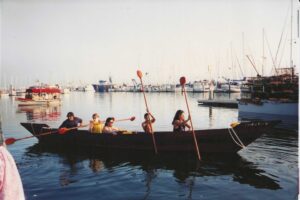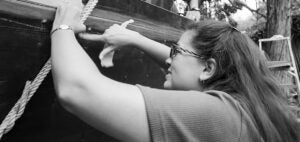USC Dornsife and The Ti’at Society partner for the preservation of Tongva/Gabrielino traditions at the Library of Congress
By Ariel Gilmore
A visitor to Los Angeles is hard-pressed to find traces of the many generations of people whose rich maritime cultures and traditions allowed them to thrive along California’s coastline and Channel Islands for at least 13,000 years.
With upwards of 70,000 tourists per year, the Channel Islands are a testament to people’s fascination with the resilience and innovation of North American sea-faring communities. Thousands of years ago the Tongva/Gabrielino people used ti’ats, or sewn-plank canoes, to transport people and cargo from Pimuu Island, better known as Santa Catalina Island, to the mainland. Then this tradition was suppressed and the art of crafting these boats was nearly lost.
But, in the early 1990s, a Tongva woman had a dream and an expert boat builder found her, and the rest is history. The Ti’at Society was born as the first ti’at to be constructed in perhaps 200 years and took shape in an effort to reclaim the traditional knowledge of making these strong, sleek, ocean-going vessels.
Thirty years later, the group sought a $50,000 grant from the Library of Congress to create an oral history that would help save the knowledge of making and navigating these flexible, fast vessels for future generations. Members of The Ti’at Society worked together to restore traditional maritime practices and preserve them for generations with support from scholars in USC’s Dornsife College of Letters, Arts, and Sciences, the USC Libraries, and Cal State University Long Beach and Cal Poly Pomona.

According to archaeologist Lynn Dodd, the USC Religion faculty member and director of the Archaeology Research Center who worked to secure funding for this project, “Loss of cultural knowledge was imminent. This is an intervention made in the hope that the first generation of ti’at makers, paddlers, and captains in centuries would not be the last generation of ti’at makers, paddlers, and captains”.
The Library of Congress Project began a couple of years ago when USC’s research dean shared a limited submission to the Library of Congress with faculty.
Dodd saw it and thought of the recent passing of beloved and knowledgeable elders, including Barbara Drake, and others.
“The loss of these culture bearers was a wake-up call that a lot more could be lost unless we launched an effort to archive or reflect on projects that had made a substantive difference within the Indigenous communities of Los Angeles. I reached out to various people to see whether they felt there would be value for them in pursuing this. The Ti’at Society felt this was important, and so we made a proposal, and it was funded!”

This project focuses on preserving heritage. This includes oral histories and interviews by community members of other community members. It also includes finding a permanent home for the first ti’at, a vessel whose name is Moomat Ahiko (“breath of the ocean”). This is happening at AltaSea the historic warehouse in the Port of Los Angeles. By making these interviews available publicly through the American Folklife Center at the Library of Congress’s website the experiences are shared in a publicly-accessible place. Likewise, by bringing Moomat Ahiko to live near the water at AltaSea, she will be a focus of learning and storytelling so that others may know about the resilience and ingenuity of Indigenous people and so that a new generation is able to put their hands to work on other ti’ats that their paddling will power through the waves.
To help secure this cultural heritage, student workers at the USC Archaeology Research Center helped by filming, editing, and transcribing these interviews to ensure that the voices of the Tongva or Gabrielino people and their knowledge of sustainable, resilient maritime culture lifeways that are unique to the coast and Channel Islands live into the future.

Audrey Joachim, a senior Anthropology major with a passion for linguistics took on the task of transcribing these interviews so that there was a written record of these oral histories.
“What’s cool about this being a Library of Congress project, is that in anthropology there is a lot of research and documentation of cultures done from an outsider’s perspective but in this project, people are talking about their culture, experiences, and world view, and how they interact with overarching society and infrastructures is not typically represented in the Library of Congress and the government. There still isn’t very much representation but this is a step in the right direction. That’s why I need to be very careful in my transcription because the whole point is to document culture and language that is reflective of the Tongva or Gabrielino and for people in positions of power to be able to refer to and be conscious of these perspectives and cultural attributes. It shouldn’t be coming from the perspective of outsiders trying to say what Indigenous people need but it’s about preserving culture and traditions that are passed down orally and to have a record that can be referenced.” The oral histories recount the maritime culture of the Tongva are rooted in tradition that spans over 10,000 years of the Channel Islands being inhabited.
Dodd recalled the time that transcribing required. “It sounds like Audrey had a simple task, to transcribe an interview; but it’s not simple. One interviewee used words from five languages (English, Spanish, Chumash, Cahuilla, Tongva), and he referred to authors, theories, nicknames, and partial proper names, so we needed to double-check everything to ensure veracity and accuracy.”
According to Lynn Dodd, “The stories passed on reveal that the ti’at is not merely a boat for this community. Rather, it is a vessel that takes them into a liminal realm in which the dimensions of air, water, earth, animal, plant and person simultaneously engage. For those who think in this way, the experience has great meaning. One Ti’at Society member compared being in the ti’at to being in a house of worship.”
This project would not have been possible without the project co-leaders Cindi Alvitre, co-founder of the Ti’at Society, and Desiree Martinez, a member of the Ti’at Society, and Tribal Relations and NAGPRA/CalNAGPRA Director at California State Polytechnic University-Pomona. They interacted with other Ti’at Society members, organized the interviews, and participated in organizing and leading the Ti’at Society at public events that celebrate the partnership between Ti’at Society and AltaSea at the Port of Los Angeles where the first ti’at, Moomat Ahiko, will reside near the water. They also guided younger community members in learning to catalog cultural heritage and they helped USC students understand how potent and tender this achievement is for community members. USC students who contributed to the project as videographers, editors, and transcribers include Laura Findlay, Ariel Gilmore, Fiona Hewitt, Gabriella Kirikian, Audrey Joachim, and Ella Grace Rodriguez. Additional counsel for this project came from Dornsife faculty members Tok Thompson (Anthropology) and Sergey Nuzhdin (Biology), and Susan Luftschein and Suzanne Noruschat of USC Libraries.
Though this first phase of the project has concluded, this archive of oral histories has prompted new possibilities in the community. Young people realize that it is special to know how to paddle a vessel for ceremony and transport. They comment that there is a renewed sense of hope for the preservation of Tongva and other maritime cultural knowledge as members of the Ti’at Society. Younger paddlers realize that their elders made it possible for them to grow up in a world where a ti’at always existed, and they are eager to ensure the same experience exists for future generations.